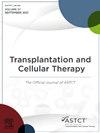Assessment of the Immunodeficiency Scoring Index for Predicting Outcomes After Respiratory Syncytial Virus Infection in Allogeneic Stem Cell Transplant Recipients
IF 3.6
3区 医学
Q2 HEMATOLOGY
引用次数: 0
Abstract
Respiratory syncytial virus (RSV) is a common cause of respiratory infections in allogeneic hematopoietic stem cell transplant (allo-HCT) recipients. The immunodeficiency scoring index (ISI) has shown predictive value in assessing the risk of progression to lower respiratory tract disease (LRTD) and mortality in allo-HCT recipients developing RSV infection but requires further validation in external cohorts. This retrospective study examined RSV episodes in adult allo-HCT recipients from December 2013 to June 2023 at 2 Spanish hospitals. The aim was to validate the predictive value of ISI for LRTD progression and infectious mortality at day +100 after RSV detection and to identify other conditions associated with disease severity. A total of 207 allo-HCT recipients developed 262 episodes of RSV infection, of which 102 (39%) progressed to LRTD. Independent variables significantly associated with LRTD risk were umbilical cord blood transplant [odds ratio (OR) 2.72, P = .016], high-risk ISI (OR 4.4, P = .008), the transplant periods between 2014 and 2016 (OR 0.31, P = .007) and after 2020 (OR 0.13, P = .026), and ribavirin use (OR 0.49, P = .047). The 100-day infectious mortality rate after RSV detection was 8.7%, increasing to 18% in those with LRTD. Variables significantly associated with the risk of mortality were donor/recipient HLA mismatch [hazard ratio (HR) 5.09, P = .011] and absolute lymphocyte count (ALC) [<0.2 × 10^9/L (HR 11.27, P = .003) and 0.2 to 1 × 10^9/L (HR 8.21, P = .008)]. ISI was associated with mortality (HR 6.8, P = .006) only when ALC categories were excluded from the multivariable model. In transplant recipients with RSV infection, a high-risk ISI category is associated with an increased risk of progression to LRTD, whereas ribavirin appears to have a protective role. Mortality in LRTD cases was influenced by HLA mismatch and different levels of lymphopenia, factors which if incorporated may enhance the ISI's ability to predict mortality.
异体干细胞移植受者呼吸道合胞病毒感染后免疫缺陷评分指数预测预后的评估:抗逆转录病毒感染后ISI的表现。
背景:呼吸道合胞病毒(RSV)是异基因造血干细胞移植(alloo - hct)受者呼吸道感染的常见原因。免疫缺陷评分指数(ISI)在评估异基因hct受者发展为RSV感染的下呼吸道疾病(LRTD)进展风险和死亡率方面显示出预测价值,但需要在外部队列中进一步验证。方法:本回顾性研究调查了2013年12月至2023年6月在西班牙两家医院接受同种异体病毒ct治疗的成人RSV发作情况。目的是验证ISI对RSV检测后第100天LRTD进展和感染性死亡率的预测价值,并确定与疾病严重程度相关的其他情况。结果:207例同种异体hct受者发生262次RSV感染,其中102例(39%)发展为下呼吸道感染。与LRTD风险显著相关的自变量为脐带血移植[比值比(OR) 2.72, p=0.016]、高危ISI (OR 4.4, p=0.008)、2014-2016年移植期间(OR 0.31, p=0.007)和2020年之后(OR 0.13, p=0.026)以及利巴韦林使用(OR 0.49, p=0.047)。RSV检测后100天感染性死亡率为8.7%,LRTD患者死亡率为18%。与死亡风险显著相关的变量是供体/受体HLA不匹配[危险比(HR) 5.09, p=0.011]和绝对淋巴细胞计数(ALC)[结论:在RSV感染的移植受者中,ISI高风险类别与进展为LRTD的风险增加相关,而利巴韦林似乎具有保护作用。]LRTD病例的死亡率受HLA错配和不同程度淋巴细胞减少的影响,如果结合这些因素,可能会增强ISI预测死亡率的能力。
本文章由计算机程序翻译,如有差异,请以英文原文为准。
求助全文
约1分钟内获得全文
求助全文
来源期刊

Transplantation and Cellular Therapy
Medicine-Hematology
CiteScore
7.00
自引率
15.60%
发文量
1061
审稿时长
51 days
 求助内容:
求助内容: 应助结果提醒方式:
应助结果提醒方式:


